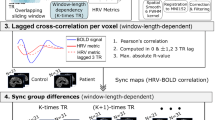Abstract
Familial dysautonomia (FD) is a disease characterized by dysfunction of the autonomic and sensory nervous systems. During the last five decades, the average life span of patients with FD has increased substantially. Nevertheless, sudden or unexplained death remains the most common cause of death in FD. Recently, our group reported that cardiac remodeling and hypertrophy are common in FD patients. We also described asymptomatic contractile dysfunction in some FD patients. It was speculated that repolarization abnormalities increases the risk of sudden death in patients with FD. However, data regarding repolarization dynamics in FD patients are limited. Twelve patients with FD and 12 healthy individuals (age and sex matched) underwent 5-min electrocardiograms. Time domain analysis of QT dynamics, power spectral analysis, QT variability index (QTVI), and normalized QT variance (QTVN) were computed. There was no difference in the time domain analysis of QT dynamics parameters between the two groups. QTVI(RR) was also not statistically different. QTVI(HR) was lower in the FD group compared to controls, but both values were low (therefore not considered pro-arrythmogenic) compared to published data. QTVN, not influenced by heart rate variability, was significantly higher in the FD group (0.39 ± 0.1% vs. 0.3 ± 0.05%, p = 0.032). In conclusion, most QT dynamics parameters in patients with FD are similar to that of normal controls. Nevertheless, FD patients have significantly higher QTVN, which might indicate higher risk for ventricular arrhythmias.

Similar content being viewed by others
References
Task Force of the European Society of Cardiology the North American Society of Pacing Electrophysiology (1996) Heart rate variability: standards of measurement, physiological interpretation and clinical use. Circulation 93:1043–1065
Axelrod FB (2002) Hereditary sensory and autonomic neuropathies. Familial dysautonomia and other HSANs. Clin Auton Res 12(Suppl 1):I2–I14
Axelrod FB (2004) Familial dysautonomia. Muscle Nerve 29:352–363
Axelrod FB (2006) A world without pain or tears. Clin Auton Res 16:90–97
Axelrod FB, Goldberg JD, Ye XY, Maayan C (2002) Survival in familial dysautonomia: impact of early intervention. J Pediatr 141:518–523
Axelrod FB, Putman D, Berlin D, Rutkowski M (1997) Electrocardiographic measures and heart rate variability in patients with familial dysautonomia. Cardiology 88:133–140
Bartoletti A (2005) Cardiac pacing in patients with familial dysautonomia: there is nothing simple about sudden death. Clin Auton Res 15:6–9
Berger RD (2003) QT variability. J Electrocardiol 36(Suppl):83–87
Berger RD, Kasper EK, Baughman KL, Marban E, Calkins H, Tomaselli GF (1997) Beat-to-beat QT interval variability: novel evidence for repolarization lability in ischemic and nonischemic dilated cardiomyopathy. Circulation 96:1557–1565
Desai N, Raghunandan DS, Mallavarapu M, Berger RD, Yeragani VK (2004) Beat-to-beat heart rate and QT variability in patients with congestive cardiac failure: blunted response to orthostatic challenge. Ann Noninvas Electrocardiol 9:323–329
Glickstein JS, Axelrod FB, Friedman D (1999) Electrocardiographic repolarization abnormalities in familial dysautonomia: an indicator of cardiac autonomic dysfunction. Clin Auton Res 9:109–112
Glickstein JS, Schwartzman D, Friedman D, Rutkowski M, Axelrod FB (1993) Abnormalities of the corrected QT interval in familial dysautonomia: an indicator of autonomic dysfunction. J Pediatr 122:925–928
Gold-von Simson G, Axelrod FB (2006) Familial dysautonomia: update and recent advances. Curr Probl Pediatr Adolesc Health Care 36:218–237
Gold-von Simson G, Rutkowski M, Berlin D, Axelrod FB (2005) Pacemakers in patients with familial dysautonomia: a review of experience with 20 patients. Clin Auton Res 15:15–20
Goldenberg I, Moss AJ, Zareba W (2006) QT interval: how to measure it and what is “normal”. J Cardiovasc Electrophysiol 17:333–336
Haigney MC, Zareba W, Gentlesk PJ, Goldstein RE, Illovsky M, McNitt S, Andrews ML, Moss AJ (2004) QT interval variability and spontaneous ventricular tachycardia or fibrillation in the multicenter automatic defibrillator implantation trial (MADIT) II patients. J Am Coll Cardiol 44:1481–1487
Hilz MJ (2002) Assessment and evaluation of hereditary sensory and autonomic neuropathies with autonomic and neurophysiological examinations. Clin Auton Res 12(Suppl 1):I33–I43
Hilz MJ, Kolodny EH, Neuner I, Stemper B, Axelrod FB (1998) Highly abnormal thermotests in familial dysautonomia suggest increased cardiac autonomic risk. J Neurol Neurosurg Psychiatry 65:338–343
Lehavi O, Aizenstein O, Bercovich D, Pavzner D, Shomrat R, Orr-Urtreger A, Yaron Y (2003) Screening for familial dysautonomia in Israel: evidence for higher carrier rate among polish Ashkenazi Jews. Genet Test 7:139–142
Levy D, Garrison RJ, Savage DD, Kannel WB, Castelli WP (1990) Prognostic implications of echocardiographically determined left ventricular mass in the Framingham heart study. N Engl J Med 322:1561–1566
Nussinovitch U, Katz U, Nussinovitch M, Nussinovitch N (2009) Late ventricular potentials and QT dispersion in familial dysautonomia. Pediatr Cardiol 30:747–751
Nussinovitch U, Katz U, Nussinovitch M, Blieden L, Nussinovitch N (2009) Echocardiographic abnormalities in familial dysautonomia. Pediatr Cardiol 30:1068–1074
Piccirillo G, Germano G, Quaglione R, Nocco M, Lintas F, Lionetti M, Moise A, Ragazzo M, Marigliano V, Cacciafesta M (2002) QT-interval variability and autonomic control in hypertensive subjects with left ventricular hypertrophy. Clin Sci (Lond) 102:363–371
Piccirillo G, Magri D, Matera S, Magnanti M, Torrini A, Pasquazzi E, Schifano E, Velitti S, Marigliano V, Quaglione R, Barilla F (2007) QT variability strongly predicts sudden cardiac death in asymptomatic subjects with mild or moderate left ventricular systolic dysfunction: a prospective study. Eur Heart J 28:1344–1350
Solaimanzadeh I, Schlegel TT, Feiveson AH, Greco EC, DePalma JL, Starc V, Marthol H, Tutaj M, Buechner S, Axelrod FB, Hilz MJ (2008) Advanced electrocardiographic predictors of mortality in familial dysautonomia. Auton Neurosci 144:76–82
Zareba W, Bayes de Luna A (2005) QT dynamics and variability. Ann Noninvas Electrocardiol 10:256–262
Acknowledgments
We thank Dr. Hillary Voet of the Hebrew University of Jerusalem, Faculty of Agricultural Food and Environmental Quality Sciences, for her assistance with the statistical analysis. We also thank Gloria Ginzach and Phyllis Curchack Kornspan for their editorial assistance. This study is dedicated to the memory of Haim Gueron.
Author information
Authors and Affiliations
Corresponding author
Rights and permissions
About this article
Cite this article
Nussinovitch, U., Katz, U., Nussinovitch, M. et al. Beat-to-Beat QT Interval Dynamics and Variability in Familial Dysautonomia. Pediatr Cardiol 31, 80–84 (2010). https://doi.org/10.1007/s00246-009-9575-2
Received:
Accepted:
Published:
Issue Date:
DOI: https://doi.org/10.1007/s00246-009-9575-2




